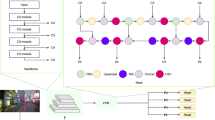Abstract
The emergence of Internet of things (IoT) technology has significantly influenced daily life and promoted the development of intelligent transportation systems and pilotless automobiles. In complex traffic environments such as curves and intersections, pilotless automobiles face some problems in pedestrian recognition, such as low detection distance accuracy and occlusion. To improve the timeliness of end-to-end information interaction and the early warning effect of anti-collision systems, a pedestrian target information fusion algorithm based on adaptive machine learning is proposed in the environment of Internet of vehicles (IoV). The pedestrian information acquired by roadside and on-board cameras is pretreated using a Kalman filter; then, the best position of the pedestrian target can be estimated and confirmed by integrating the time–space alignment, fuzzy association, and Kalman filtering results. Experiments show that both the maximum absolute error and the absolute mean error of the pedestrian trajectory are reduced significantly, i.e., by 45.0% and 58.5%, respectively, compared with those before trajectory fusion. Compared with S-LSTM and S-GAN methods, reasoning time is greatly reduced.Thus, the accuracy of pedestrian trajectory detection is improved by the fusion algorithm, and the warning accuracy of the system is enhanced.



Similar content being viewed by others
References
Zhang Y, Liu W, Wu Y (2013) A fast pedestrian detection method for vehicle auxiliary driving system. J Highw Transp Res Dev 11:131–138
Wang J, Wang H, Liu J, Li K (2013) Intersection vehicle driving assistance system based on vehicle-to-infrastructure communication. China J Highw Transp 26(4):170–175
Wang D, Song X, Zhu S, Chen Y, Cai S (2012) Early warning control of expressway confluence area based on vehicle road cooperation. J Highw Transp Res Dev S1:50–56
Lu G, Song Y (2014) Driving behaviors and traffic safety under an environment of cooperative vehicle infrastructure systems. J Transp Inf Saf 5(32):13–19
Yamaguchi R, Ikeda D, Nakanishi Y, Wada T, Okada H (2008) A cooperative reflect transmission scheme using road infrastructure in vehicle-PEdestrian communications. In: 2008 IEEE 68th vehicular technology conference (pp 1–5). IEEE
Becker D, Schaufele B, Einsiedler J, Sawade O, Radusch I (2014) Vehicle and pedestrian collision prevention system based on smart video surveillance and C2I communication. In: 17th international IEEE conference on intelligent transportation systems (ITSC) (pp 3088–3093). IEEE
Ma GS, Zhu T, Yang XG (2009) Prediction of potential pedestrian-to-vehicle conflict at unsignalized intersection based on VII. In: 2009 IEEE international conference on intelligent computing and intelligent systems (vol 2, pp 632–635). IEEE
Alahi A, Goel K, Ramanathan V et al (2016) Social LSTM: Human Trajectory Prediction in Crowded Spaces. In: 2016 IEEE conference on computer vision and pattern recognition (CVPR). IEEE
Gupta A, Johnson J, Li FF et al (2018) Social GAN: socially acceptable trajectories with generative adversarial networks. In: 2018 IEEE/CVF conference on computer vision and pattern recognition (CVPR)
Jiyu Y, Xian L, Mingye Y (2021) Short-term social conflict prediction for pedestrians based on YOLOv3 and kalman filter. Transducer Microsyst Techol 40(6):133-137+141. https://doi.org/10.13873/J.1000-9787(2021)06-0133-05
Chaochun Y, Jinxing S, Youguo He et al (2021) Autonomous vehicle active collision avoidance algorithm based on pedestrian trajectory prediction. J Jiangsu Univ Nat Sci Edit 42(1):8
Yoneda R, Okuda K, Uemura W (2013) A tight curve warning system using FSK visible light and road-to-vehicle communication. In: 2013 IEEE third international conference on consumer electronics, Berlin (ICCE-Berlin) (pp 1–3). IEEE
Peng J, Wang J, Wang N (2011) Intelligent vehicle collision warning algorithm based on machine vision. J Highw Transp Res Dev 28(S1):124–128
Wei QCC (2011) Realization of Kalman filter in aircraft attitude acquisition system. J Trans Inf Saf
Yu J, Chen W, Liu J, Lu HY (2013) Key technologies for VTS and AIS information fusion in the inland waterway. J Transp Inf Saf 31(6):113–118
Li W (2006) Discussing information fusion about radar and AIS in VTS. China Water Transp 6(7):116–118
Guangquan LU, Yibing LI (2005) Technique of photogrammetry in accident reconstruction using common digital camera and its progress. J Transp Eng Info 3(3):63–67
He Y (2010) Information fusion theory with applications. Publishing House of Electronics Industry, Beijing
Zhang P, Ouyang W, Zhang P et al (2019) SR-LSTM: State Refinement for LSTM towards Pedestrian Trajectory Prediction. In: Proceedings of the IEEE/CVF conference on computer vision and pattern recognition. IEEE
Acknowledgements
This project was supported by National Natural Science Foundation of China Youth Science Fund Project (52002298), Hubei Provincial Natural Science Foundation Program Youth Project (2020CFB118), Hubei Provincial Department of Education Science and Technology Research Program Young Talent Project (Q20201107), "Transportation Vehicle Inspection, Diagnosis and Maintenance Technology" Open Project of Key Laboratory of Transportation Industry (JTZL1903), and Key R & D Project of Hubei Province, Research and Application of Advanced Automatic Driving Key Technologies in Complex Driving Environment (2020AA001).
Author information
Authors and Affiliations
Corresponding author
Additional information
Publisher's Note
Springer Nature remains neutral with regard to jurisdictional claims in published maps and institutional affiliations.
Rights and permissions
Springer Nature or its licensor (e.g. a society or other partner) holds exclusive rights to this article under a publishing agreement with the author(s) or other rightsholder(s); author self-archiving of the accepted manuscript version of this article is solely governed by the terms of such publishing agreement and applicable law.
About this article
Cite this article
Cheng, M., Yan, Y., Han, Y. et al. Adaptive machine learning algorithm for human target detection in IoT environment. Computing 106, 1139–1150 (2024). https://doi.org/10.1007/s00607-022-01123-z
Received:
Accepted:
Published:
Issue Date:
DOI: https://doi.org/10.1007/s00607-022-01123-z




